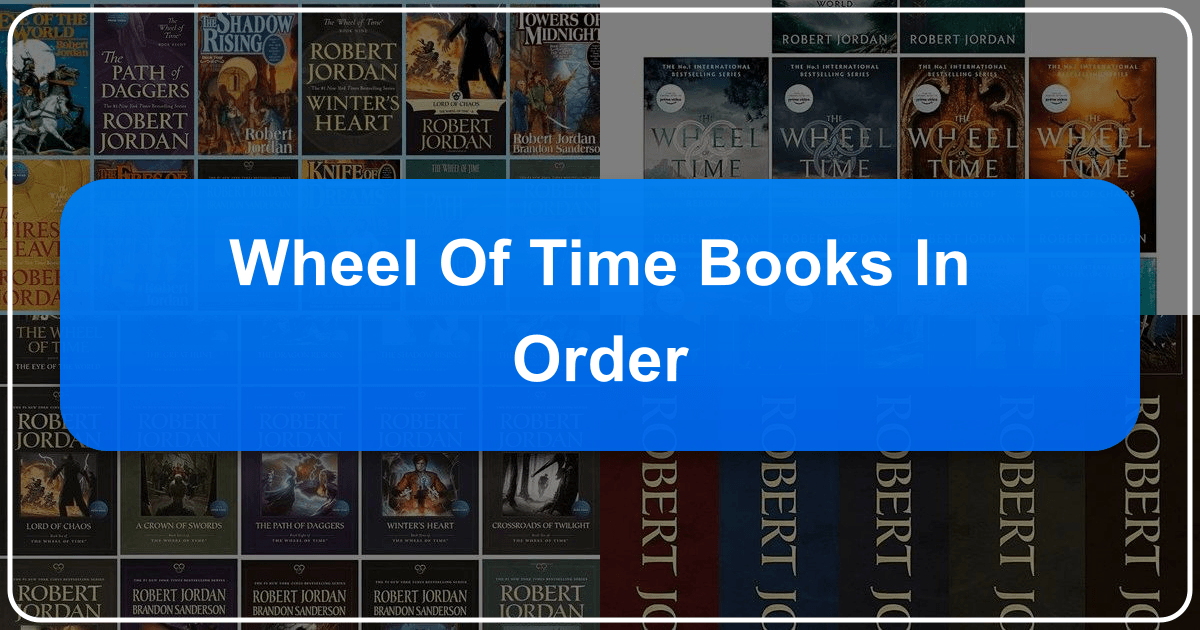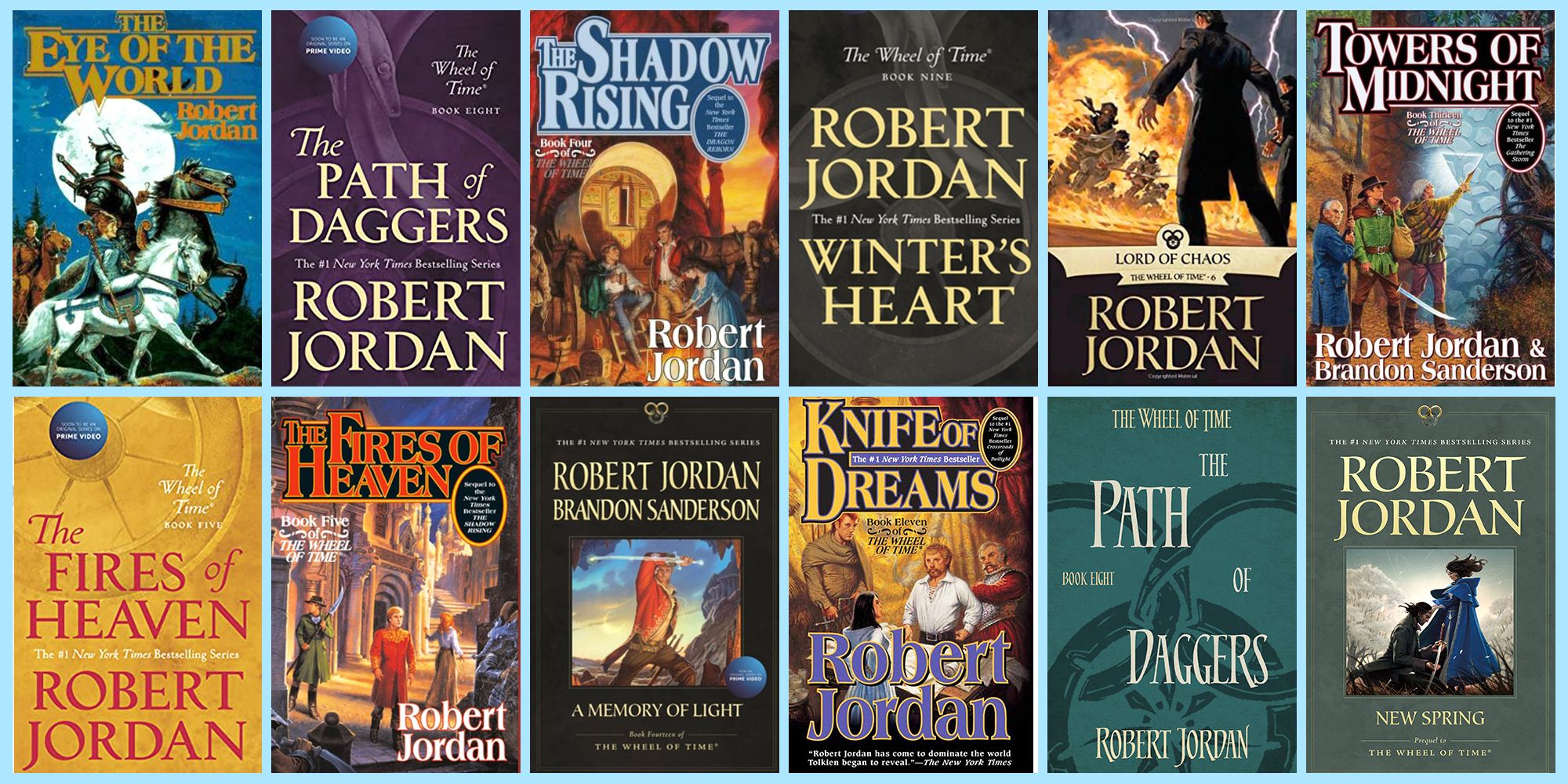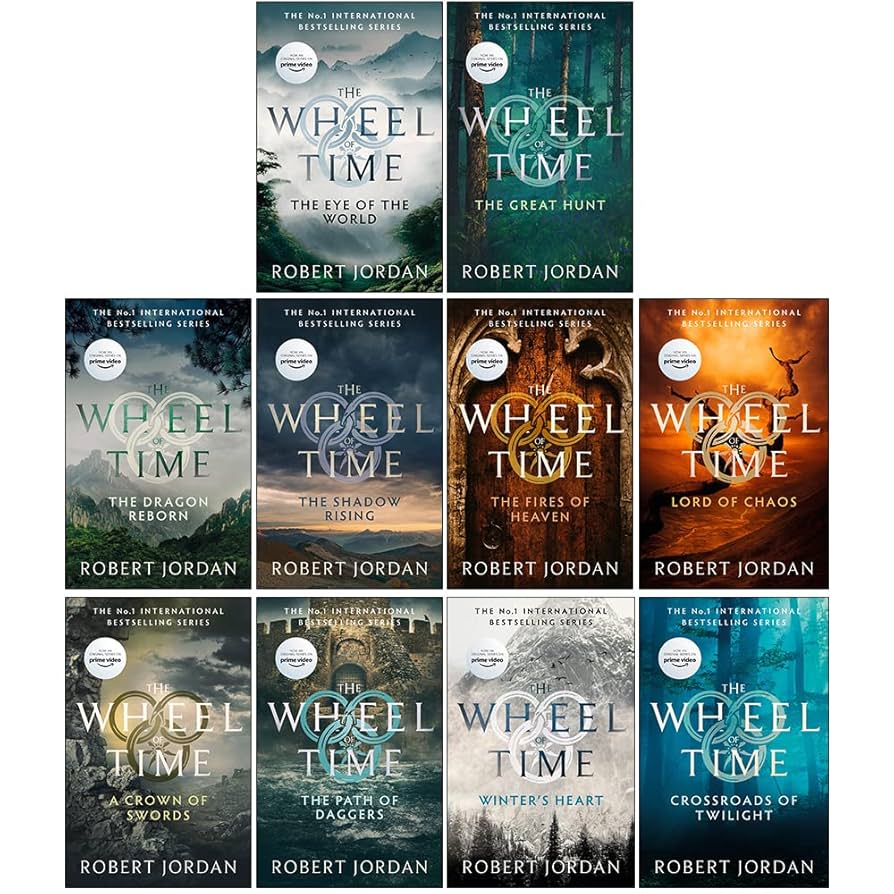The Wheel of Time Books in Order: A Comprehensive Guide

Robert Jordan’s The Wheel of Time series stands as a monumental achievement in epic fantasy literature. Spanning 15 books, it’s a sprawling saga of prophecy, destiny, and the eternal struggle between light and shadow. With the Amazon Prime adaptation bringing the story to a wider audience, many are seeking a guide to navigate this epic world. This comprehensive guide will explore The Wheel of Time books in publication order, delve into the series’ literary impact, and provide insights into the rich world Jordan created.

Navigating the Wheel of Time: Reading Order and Key Themes
The best way to experience the immersive world of The Wheel of Time is to read the books in their original publication order. This allows the narrative to unfold as Jordan intended, building the complexities of the world and characters gradually. While the Amazon Prime series takes liberties with the source material, reading the books first provides a deeper appreciation for the nuances and scope of the story.
The series begins with The Eye of the World, introducing us to the idyllic village of Emond’s Field and the arrival of Moiraine Damodred, an Aes Sedai seeking the Dragon Reborn. The subsequent books follow the Dragon Reborn’s journey, his struggle to master the One Power (a source of immense magical potential), and the escalating conflict against the Dark One.

The final three books were completed by Brandon Sanderson after Jordan’s death in 2007, utilizing Jordan’s extensive notes. Sanderson successfully maintained the series’ integrity and delivered a satisfying conclusion, echoing Jordan’s intended narrative.
Key themes throughout The Wheel of Time resonate throughout the series. These themes include:
-
The cyclical nature of time: Drawing from global mythologies, the concept of the Wheel of Time, constantly turning and repeating ages, is central. This emphasizes the cyclical nature of history and the repeating patterns of destiny.
-
Fate versus free will: The characters grapple with the weight of prophecy and predetermined destinies, constantly questioning whether they are truly free to choose their own paths.
-
Good versus evil: The inherent duality of human nature and the ongoing struggle between the forces of light and shadow dominate the narrative. This central conflict drives the plot and influences the moral choices of the characters.
-
Power and corruption: The allure and corrupting influence of the One Power (magic) on individuals and society is a consistent theme. The potential for misuse of power and the consequences that follow are explored in detail.
-
Friendship and loyalty: The strength of bonds between characters, their unwavering support for each other despite adversity, are central to the narrative. The power of friendship and loyalty sustains them throughout their perilous journeys.
The Wheel of Time Books in Publication Order: A Synopsis
Here’s a brief look at each book, outlining the primary plot points and highlighting what makes each installment unique:
-
The Eye of the World: The story begins in the seemingly peaceful village of Emond’s Field, where Moiraine Damodred reveals the looming threat of the Dark One and the search for the Dragon Reborn. This introduces the main characters and sets the stage for the epic journey to follow.
-
The Great Hunt: The Horn of Valere, a powerful artifact that summons dead heroes, is stolen. The ensuing quest to recover it tests Rand’s abilities and reveals more about his destiny.

-
The Dragon Reborn: Rand is publicly declared the Dragon Reborn, and the quest for the mythical crystal sword Callendor begins. This book solidifies Rand’s role as a pivotal figure in the conflict and introduces new allies and enemies.
-
The Shadow Rising: Rand journeys to the Aiel Waste, a harsh desert region inhabited by formidable warriors. He seeks their leadership, facing challenges that force him to confront his past and master the One Power.
-
The Fires of Heaven: Rand defends Cairhien from dark forces, solidifies his leadership, and engages in a battle that leads him into the world of dreams. This book intensifies the conflict and expands the scope of the war against the Shadow.
-
Lord of Chaos: Rand trains a new legion of male channelers, and political intrigue threatens his power. He is kidnapped and tortured, leading to a climactic battle that strengthens his position as the Dragon Reborn.
-
A Crown of Swords: Rand’s friends search for the Bowl of the Winds, a magical artifact, while female channelers assemble. Rand also works to quell a rebellion. This installment highlights the interconnected nature of the quests and emphasizes the importance of cooperation.
-
The Path of Daggers: The Aes Sedai reverse the Dark One’s climate manipulation. Rand faces further challenges, including an attack from a traitor.
-
Winter’s Heart: Rand remains on the run, while his friends pursue their destinies. Mat’s quest for his prophesied bride, Perrin’s pursuit of his wife’s kidnapper, and Rand’s secret paternity converge. This book includes a significant turning point when Rand cleanses saidin.
-
Crossroads of Twilight: Perrin’s relentless quest to rescue his wife, Mat’s courtship of the Daughter of the Nine Moons, and Rand’s undisclosed paternity all converge, testing alliances and revealing hidden truths. The convergence of these plots highlights the intertwined fate of the characters.
-
Knife of Dreams: This was Robert Jordan’s last completed novel. Unusual events signal the approach of the Last Battle, and Rand confronts his alter-ego, Lews Therin, resulting in a pivotal conflict that leaves him injured and his fate uncertain.
-
The Gathering Storm: Brandon Sanderson takes over the narrative here, continuing the story from Jordan’s extensive notes. Rand must rally the world’s forces while battling his own internal demons. The Last Battle draws ever closer.
-
Towers of Midnight: The world is crumbling in the final days before the Last Battle. Mat and Perrin must unite their followers, face their destinies, and draw on their inner strengths for the ultimate confrontation.
-
A Memory of Light: The Last Battle commences, culminating in a final duel between Rand and the Dark One. The outcome determines the fate of the world and leaves open several intriguing possibilities.
The Author: Robert Jordan (and Brandon Sanderson)
Robert Jordan, born James Oliver Rigney Jr., was a master of world-building and epic storytelling. His military background and academic training in physics informed his richly detailed worlds and complex plotlines. His meticulous planning and extensive notes were crucial in allowing Brandon Sanderson to successfully complete the final three books.
Sanderson, another celebrated fantasy author, seamlessly integrated his writing style with Jordan’s, ensuring a consistent voice and a faithful continuation of the original author’s vision. His expertise in magic systems and complex plotting was particularly vital in resolving the intricate threads woven throughout the series.
Robert Jordan’s Writing Style and Inspirations
Jordan’s writing is characterized by its vast scope, detailed descriptions, and compelling character development. His world-building is legendary, drawing inspiration from diverse mythologies and cultures. This blend of historical and fictional elements creates a unique and immersive reading experience.
His inspirations are evident throughout The Wheel of Time. While the overall structure of his work may bear some resemblance to Tolkien’s The Lord of the Rings, Jordan also drew from various other sources such as Celtic and Norse mythology, weaving a tapestry that is both familiar and uniquely his own.
Famous Works of Robert Jordan
Beyond The Wheel of Time, Robert Jordan penned several other novels, though none reached the same level of fame and influence as his magnum opus. These demonstrate his skill in storytelling but his impact is mainly attributed to his incredible The Wheel of Time.
Cultural Impact: The Enduring Legacy of The Wheel of Time
The Wheel of Time transcends mere entertainment, leaving an indelible mark on the fantasy genre. Its popularity has spurred:
-
Literary influence: The series’ influence is felt in subsequent fantasy works, both in terms of scope and thematic concerns. The series itself is a product of fantasy authors prior to Jordan but it created a new style of writing, a new paradigm for the genre.
-
Adaptations: The Amazon Prime Video series is a testament to the ongoing relevance and appeal of The Wheel of Time. It introduced the series to a new generation of viewers, expanding its reach beyond its already vast readership.
-
Awards and Recognition: While the series may not have won any major literary awards, its cultural significance and phenomenal success speak volumes about its quality and impact. Its popularity proves its success without awards, a legacy in itself.
-
Communities: The passionate and dedicated fanbase that has emerged around The Wheel of Time is a testament to the power of this intricate world. It continues to thrive through online forums, fan fiction, and countless discussions dedicated to the series and the world it built.
Reading and Learning: Educational Value and Life Lessons
Beyond the captivating narrative, The Wheel of Time offers several avenues for educational growth and personal reflection:
-
Summaries and Discussions: Numerous online resources offer summaries, character analyses, and detailed discussions of the books, which provides a means to enhance comprehension and explore the complex narrative in greater depth.
-
Educational Value: The intricate world-building, political maneuvering, and exploration of diverse cultures and mythologies can enhance understanding of world history and comparative mythology. The series allows for learning in disguise.
-
Life Lessons: The Wheel of Time explores universal themes such as overcoming adversity, the nature of good and evil, the corrupting influence of power, and the enduring power of friendship and love. The series illustrates life lessons in a fantastical setting.
-
Reading Habits: The sheer length of the series is a testament to the power of long-form storytelling, offering both a challenge and a significant reward for dedicated readers. The reading itself can be used to practice reading stamina and dedication.
This comprehensive guide only scratches the surface of the rich tapestry that is Robert Jordan’s The Wheel of Time. Its vast scope, intricate characters, and exploration of fundamental human experiences ensure its enduring legacy for years to come. Whether you are a long-time fan or a newcomer to this expansive world, the journey promises to be both challenging and deeply rewarding.